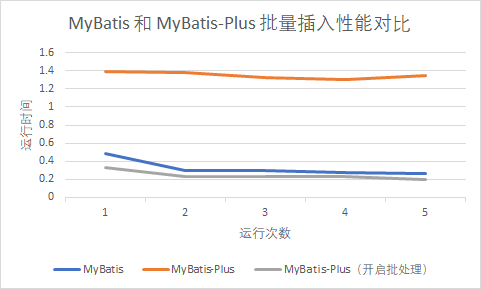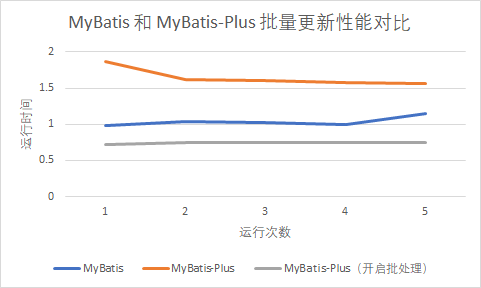對比 MyBatis 和 MyBatis-Plus 批次插入、批次更新的效能和區別
1 環境準備
demo 地址:learn-mybatis · Sean/spring-cloud-alibaba - 碼雲(gitee.com)
1.1 搭建 MyBatis-Plus 環境
- 建立 maven springboot 工程
- 匯入依賴:web 啟動器、jdbc、、java 連線 mysql、Lombok、druid 連線池啟動器、mybatis-plus 啟動器
- 編寫 yaml 組態檔,設定 druid 資料來源、mybatis-plus
注意要點:
- mapper 介面繼承 BaseMapper<實體類>
- service 介面繼承 IService<實體類>
- service 介面實現類繼承 ServiceImpl<mapper 介面, 實體類> 實現 service 介面
1.2 批次插入測試介面
- MyBatis 批次插入介面
Mybatis 的批次插入是呼叫 mapper 的批次插入介面,使用@GetMapping("/mybatis-batch-insert") public String mybatisBatchInsert(){ // 開始時間 long stime = System.currentTimeMillis(); // 批次插入 orderService.mySaveBatch(list); // 結束時間 long etime = System.currentTimeMillis(); return "mybatis 批次插入 1w 條資料的時間: " + (etime - stime) / 1000.0 + "秒"; }標籤拼接 sql 進行插入 - Mybatis-Plus 批次插入介面
MyBatis-Plus 的批次插入是呼叫 mybatis-plus 的 IService 介面的 saveBatch 進行批次插入@GetMapping("/mybatis-batch-insert") public String mybatisBatchInsert(){ // 開始時間 long stime = System.currentTimeMillis(); // 批次插入 orderService.mySaveBatch(list); // 結束時間 long etime = System.currentTimeMillis(); return "mybatis 批次插入 1w 條資料的時間: " + (etime - stime) / 1000.0 + "秒"; }
1.3 批次更新測試介面
-
MyBatis 批次更新介面
@GetMapping("/mybatis-batch-update") public String mybatisBatchUpdate(){ long stime = System.currentTimeMillis(); orderService.myUpdateBatchById(updateList); long etime = System.currentTimeMillis(); return "mybatis 批次更新 1w 條資料的時間: " + (etime - stime) / 1000.0 + "秒"; }MyBatis 的批次插入是呼叫 mapper 的批次更新介面,使用
標籤拼接 sql 進行更新,是將多個更新語句拼接在同一個 mapper 介面中,需要在資料庫連線 url 新增 allowMultiQueries=true 開啟多查詢 -
MyBatis-Plus 批次更新介面
@GetMapping("/mybatis-plus-batch-update") public String mybatisPlusBatchUpdate(){ long stime = System.currentTimeMillis(); orderService.updateBatchById(updateList); long etime = System.currentTimeMillis(); return "mybatis plus 批次更新 1w 條資料的時間: " + (etime - stime) / 1000.0 + "秒"; }MyBatis -Plus 的批次更新是呼叫 mybatis-plus 的 IService 介面的 updateBatchById 進行批次更新
2. 效能對比
經過預熱,儘量避免了快取的影響。
2.1 批次插入效能對比

資料量:1w 條資料,每條資料 4 個欄位
測試結果:
- MyBatis:5 次執行平均耗時:0.3212 秒
- MyBatis-Plus:5次執行平均耗時:1.35 秒
- MyBatis-Plus(開啟批次處理):5次執行平均耗時:0.2424 秒
2.2 批次更新效能對比

資料量:1w 條資料,每條資料更新 4 個欄位
測試結果:
- MyBatis:5 次執行平均耗時:1.0378 秒
- MyBatis-Plus:5次執行平均耗時:1.6448 秒
- MyBatis-Plus(開啟批次處理):5次執行平均耗時:0.743 秒
3. 原理探究
3.1 批次插入
3.1.1 MyBatis
MyBatis 的批次插入 xml
<insert id="mySaveBatch">
insert into order_table(id, product_id, total_amount, status) values
<foreach collection="list" separator="," item="item">
(#{item.id}, #{item.productId}, #{item.totalAmount}, #{item.status})
</foreach>
</insert>
通過
insert into order_table(id, product_id, total_amount, status) values(1, 2. 2.0, 1),(2, 2, 2.0, 1);
3.1.2 MyBatis-Plus
MyBatis-Plus 的批次插入本質採用 for 遍歷每條資料依次插入,但使用了批次處理優化,預設是每 1000 條資料,重新整理一次 statement 提交到資料庫,執行插入操作。
注意:批次處理需要在資料庫連線中新增 rewriteBatchedStatements=true 否則 jdbc 驅動在預設情況下會無視executeBatch() 語句
原始碼如下:
@Transactional(rollbackFor = Exception.class) // 開啟事務
@Override
public boolean saveBatch(Collection<T> entityList, int batchSize) {
String sqlStatement = getSqlStatement(SqlMethod.INSERT_ONE); // 獲得插入 statement
// 執行批次處理操作
// 引數是:待插入集合,批次大小(預設1000),函數式介面 accept
return executeBatch(entityList, batchSize, (sqlSession, entity) -> sqlSession.insert(sqlStatement, entity));
}
public static <E> boolean executeBatch(Class<?> entityClass, Log log, Collection<E> list, int batchSize, BiConsumer<SqlSession, E> consumer) {
Assert.isFalse(batchSize < 1, "batchSize must not be less than one");
return !CollectionUtils.isEmpty(list) && executeBatch(entityClass, log, sqlSession -> {
int size = list.size();
int idxLimit = Math.min(batchSize, size);
int i = 1;
// 遍歷插入
for (E element : list) {
// 呼叫 sqlSession.insert(sqlStatement, entity));
// 對元素執行插入操作,但此時資料庫還沒真正執行插入語句
consumer.accept(sqlSession, element);
// 計數達到 1000 或者 集合結束
if (i == idxLimit) {
// 重新整理 statement 提交批次處理語句,資料庫真正執行 SQL
sqlSession.flushStatements();
idxLimit = Math.min(idxLimit + batchSize, size);
}
i++;
}
});
}
3.2 批次更新
3.2.1 MyBatis
MyBatis 的批次更新 xml
<update id="myUpdateBatchById">
<foreach collection="list" item="item" index="index" open="" close="" separator=";">
update order_table
<set>
product_id = #{item.productId},
total_amount = #{item.totalAmount},
status = #{item.status}
</set>
where id = #{item.id}
</foreach>
</update>
通過
update order_table set product_id = 1, total_amount = 2, status = 1 where id = 1;
update order_table set product_id = 1, total_amount = 2, status = 1 where id = 2;
3.1.2 MyBatis-Plus
MyBatis-Plus 批次更新的原理基本和其批次插入的原理一致,都是呼叫 executeBatch 執行批次處理操作。
4. 優缺點分析
4.1 批次插入
對於批次插入,MyBatis 拼接 SQL 的寫法比 MyBatis-Plus 的批次插入方法有明顯更高的效能。
但在開啟批次處理優化之後,MyBatis-Plus 的方法效能更高了。
MyBatis:
- 優點:效能較高
- 缺點:在處理巨量資料量(SQL 語句大於 64MB 時)會報錯,MySQL 8.0.33 預設最大 SQL 大小為 64MB
也要考慮記憶體異常等問題。
MyBatisPlus:
- 優點:分組提交,適用於巨量資料量的處理
- 缺點:單條插入語句執行,效能較低
總結:
- 沒開啟批次處理時:10w 資料量以下建議使用 MyBatis、10w 資料量以上建議使用 MyBatis-Plus
- 開啟批次處理時:建議使用 MyBatis-Plus
4.2 批次更新
對於批次更新,MyBatis 拼接 SQL 的寫法與 MyBatis-Plus 的批次更新方法無明顯的效能差別.
大於巨量資料量,拼接寫法甚至容易出現記憶體耗盡等問題,相比之下 MyBatis-Plus 的方法更優。
總結:建議使用 MyBatis-Plus